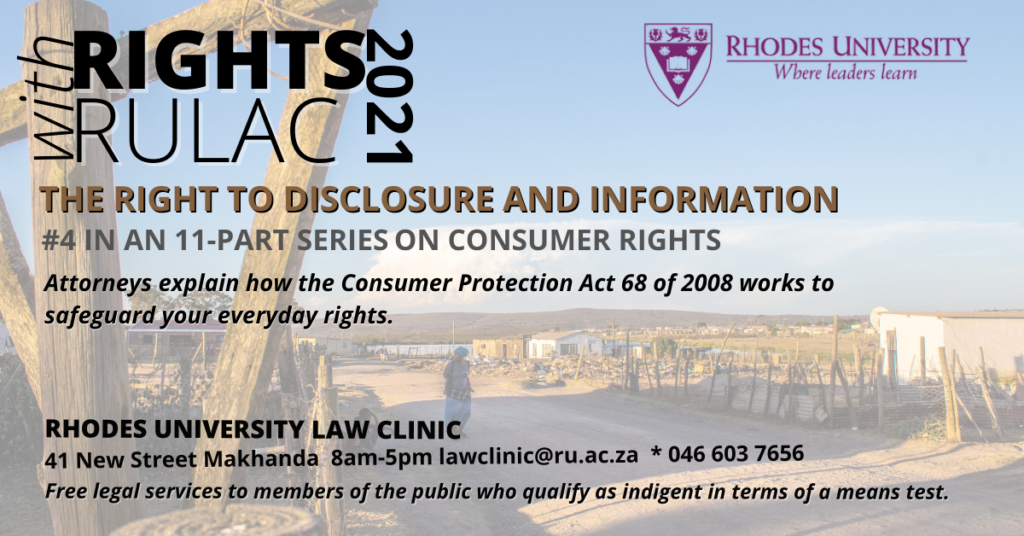By RYAN MCDONALD
The consumer’s right to disclosure and information is governed by sections 22 to 28 of the Consumer Protection Act (‘the Act’). These rights are based on the idea that consumers must have adequate information to make informed decisions or to exercise their rights.
Right to information in plain and understandable language (section 22)
The key obligation, which carries through to all of the other sections, is that consumers have the right to have information about products and services provided to them in plain and understandable language. Information includes writing and pictures.
The Act provides guidance in deciding whether something is in ‘plain and understandable language’. It must be reasonable to conclude that an ordinary consumer, with average literacy skills and little experience as a consumer, can easily understand the content, significance and importance of the information. In doing so, the following are relevant:
- The context (a notice at a car wash, or a car purchase contract);
- Comprehensiveness and consistency;
- The organisation of the document;
- Simple, clear vocabulary and sentence structure;
- The use of illustrations, examples and headings or other aids to reading and understanding.
The right therefore includes considerations of both wording and document design.
The right applies to:
- Information on product packaging;
- Wording on a written agreement;
- Terms and conditions in documents, signs or notices.
Disclosure of the price of goods or services (section 23)
A supplier is required to display the price of an item displayed for sale. It must be attached to the item in some way (eg written, printed, stamped or taped on the product), or it must be represented in such a way that the consumer is able to understand what it is (eg by a ticket or notice on a shelf). The price must be in writing and in Rands. The right in the Act applies specifically to physical stores; but similar price-disclosure requirements are set out in the Electronic Communications and Transactions Act for on-line retailers and service providers.
A supplier is bound by a display price and may not charge a price higher than the displayed price. If a price is set and then covered by another one, then the one that is most visible (the one on top) will apply.
Product labelling and trade descriptions (section 24)
Product labels and trade labels must not be misleading to the consumer. The Minister has the power to prescribe categories of goods that are required to have trade descriptions attached to them (e.g., for textiles, clothing, shoes and leather goods). A producer or importer of any goods in this context must apply the trade description disclosing:
- The country of origin of the goods, and
- Any other prescribed information (see the Regulations).
It is an offence for a supplier to use a misleading trade description, or to alter or remove one applied to goods. Examples of a trade description are:
- Made in South Africa from imported materials
- Organic
- Low-fat
Disclosure of re-conditioned or grey market goods (section 25)
If goods have been re-conditioned, rebuilt or remade, a supplier of these goods must apply a conspicuous notice to these goods warning that they have been re-conditioned, rebuilt or remade, and are not offered in their original form. A similar obligation applies to the supply of ‘grey market goods’. Grey market goods are goods that bear the trade mark of the original producer or supplier, but which are imported into South Africa without the approval or licence of the registered owner of the trade mark (eg Nike clothes/shoes, or Samsung phones). A supplier of these goods must apply a conspicuous notice to these goods warning that they have been imported without the approval or licence of the registered owner of the trade mark.
Sales records (section 26)
A supplier of goods or services must provide a written/printed record of each transaction (a receipt) to the consumer.
Identification of deliverers, installers and others (section 28)
Whenever a person is engaged in direct marketing, in person, at the consumer’s premises, or performing a service, or delivering or installing goods at the consumer’s premises, he or she is required to visibly wear or display a badge or identification device, or provide suitable identification on request by the consumer.
- Ryan McDonald is an attorney at the Rhodes University Law Clinic
Rhodes University Law Clinic helping you
The Rhodes University Law Clinic strives to improve access to justice through the provision of free legal services to indigent people in most areas of law. The Law Clinic’s New Street offices are open during ordinary business hours, and their services are available to those members of the public who qualify for assistance in terms of a means test. For more detail, please contact:
Rhodes University Law Clinic
41 New Street, Grahamstown
Telephone 046 603 7656
lawclinic@ru.ac.za
https://www.grocotts.co.za/2021/04/02/the-right-to-choose_2/
Know your rights as a consumer
This 11-part 2021 series is written by attorneys at the Rhodes Law Clinic. The articles cover various aspects of consumer rights in terms of the Consumer Protection Act 68 of 2008. Here are the articles published to date:
#1 As a consumer, do you have rights?
#2 The right to equality and the right to privacy


